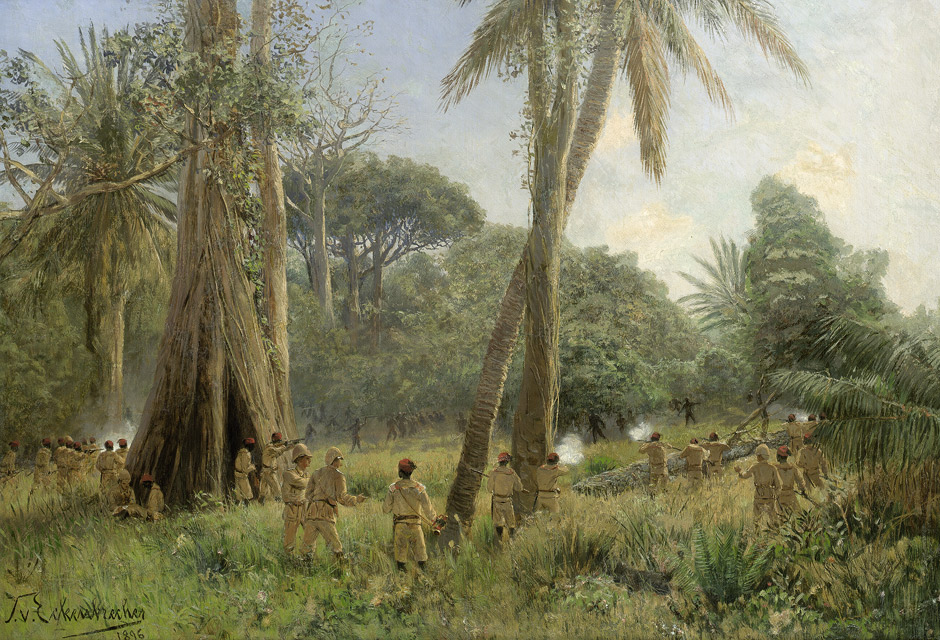|
Usambara
The Usambara Mountains of northeastern Tanzania in tropical East Africa, comprise the easternmost ranges of the Eastern Arc Mountains. The ranges of approximately long and about half that wide, are situated in the Lushoto District of the Tanga Region. They were formed nearly two million years ago by faulting and uplifting, and are composed of Precambrian metamorphic rocks. They are split into two sub-ranges; the West Usambaras being higher than the East Usambaras, which are nearer the coast and receive more rainfall. The mountains are clad in virgin tropical rainforest which has been isolated for a long period and they are a centre of endemism. Historically they were inhabited by Bantu, Shambaa, and Maasai people but in the eighteenth century, a Shambaa kingdom was founded by Mbegha. The kingdom eventually fell apart after a succession struggle in 1862. German colonists settled in the area which was to become German East Africa, and after World War I it became part of the Br ... [...More Info...] [...Related Items...] OR: [Wikipedia] [Google] [Baidu] |
Tanga Region
Tanga Region (''Mkoa wa Tanga'' in Swahili) is one of Tanzania's 31 administrative regions. The region covers an area of . The region is comparable in size to the combined land area of the nation state of Burundi. The regional capital is the municipality of Tanga city. Located in northeast Tanzania, the region is bordered by Kenya and Kilimanjaro Region to the north; Manyara Region to the west; and Morogoro and Pwani Regions to the south. It has a coastline to the east with the Indian Ocean. According to the 2012 national census, the region had a population of 2,045,205. History The region was previously known as Tanga Province and included Same and Mwanga Districts that are at present in Kilimanjaro Region. Geography Geology and terrain Tanga Region is the 15th largest region by size with an area of , after Songwe Region at . An area occupying 3% of the country. In comparison Tanga is larger than the African nation of Burundi at 25,680 square kilometers. The Tanga ... [...More Info...] [...Related Items...] OR: [Wikipedia] [Google] [Baidu] |
Usambara Eagle-owl
The Usambara eagle-owl, also called the East African nduk eagle-owl or Vosseier's eagle-owl, (''Bubo poensis vosseleri'') is a taxon of owl in the family Strigidae. It is now regarded as a subspecies of Fraser's eagle-owl (''Bubo poensis''). It is endemic to the Usambara Mountains in Tanga Region of Tanzania. Description The Usumbara eagle-owl is a large owl with tawny brown upperparts which are barred with darker brown and creamy white underparts, with brown blotches on the breast and irregular black bars on the belly. The facial disc is pale tawny with broad black borders at the sides, the long ear tufts are tawny brown. The bill is bluish white and the eyes a dull yellowish orange with bluish white eyelids, while the legs and feet are whitish. The juvenile resembles the adult but has a white line along the scapulars. The length (including the tail) is . The differences between this taxon and Fraser's eagle-owl are that it is slightly larger, a more prominent dark margin to the ... [...More Info...] [...Related Items...] OR: [Wikipedia] [Google] [Baidu] |
Shambaa People
The Shambaa people, also called the Sambaa, Shambala, Sambala or Sambara (''Wasambaa'' in Swahili), are a Bantu ethnic group. Their ancestral home is on the Usambara Mountains of Lushoto District, Bumbuli District. They are native to the valleys and eastern Usambara Mountains of Korogwe District, Korogwe Urban District and western Muheza District of northern Tanga Region of Tanzania.Katariina Vainio-Mattila (2000)Wild vegetables used by the Sambaa in the Usambara Mountains, NE Tanzania Annales Botanici Fennici, Vol. 37, No. 1 (2000), pages 57-67 The word ''Shamba'' means "farm", and these people live in one of the most fertile Tanzanian region. In 2001, the Shambaa population was estimated to number 664,000. Language The Shambaa people speak the ''Shambala'' language, also known as Kisambaa, Kishambaa, Kishambala, Sambaa, Sambala, Sambara, Schambala, Shambaa. ''Kishambaa'' is the Sambaa word for the Shambala language, ''Wasambaa'' are the people (''Msambaa'' for a person), ... [...More Info...] [...Related Items...] OR: [Wikipedia] [Google] [Baidu] |
Lushoto District
Lushoto is one of the eleven districts of Tanga Region in Tanzania. It is bordered to the northeast by Kenya, to the east by the Muheza District, to the northwest by the Kilimanjaro Region, west by Korogwe District and to the south by the Bumbuli District. The district's capital and largest town is Lushoto. History It was formerly known as ''Wilhelmstal'' (William's Valley) and was named after Emperor Wilhelm II. During the German colonial period from the 1890s to 1918 the area was popular with settlers, hence the German place name of Wilhelmstal. Large farms and plantations were created, and the district was valued for its pleasant mountain climate. Numerous church missions were, and remain, active. Between 1893 and 1911 the German ''Ostafrikanische Eisenbahngesellschaft'' (East African Railway Company) constructed an important railway line starting at Tanga on the coast and passing along the Usambara Mountains with a station at Mombo, about from Wilhelmstal, to "New" Moshi ... [...More Info...] [...Related Items...] OR: [Wikipedia] [Google] [Baidu] |
Usambara Akalat
The Usambara akalat (''Sheppardia montana''), also known as the Usambara alethe or Usambara robin-chat, is a species of bird in the family Muscicapidae. It is endemic to the Usambara Mountains in Tanga Region of Tanzania. Its natural habitat is subtropical or tropical moist montane forests. It is threatened by habitat loss Habitat destruction (also termed habitat loss and habitat reduction) is the process by which a natural habitat becomes incapable of supporting its native species. The organisms that previously inhabited the site are displaced or dead, thereby .... References Usambara akalat Endemic birds of Tanzania Usambara akalat Taxonomy articles created by Polbot {{Muscicapidae-stub ... [...More Info...] [...Related Items...] OR: [Wikipedia] [Google] [Baidu] |
Usambara Weaver
The Usambara weaver (''Ploceus nicolli'') is a species of bird in the family Ploceidae. It is endemic to Tanzania. Its natural habitats are subtropical or tropical moist montane forests and plantations . It is threatened by habitat loss Habitat destruction (also termed habitat loss and habitat reduction) is the process by which a natural habitat becomes incapable of supporting its native species. The organisms that previously inhabited the site are displaced or dead, thereby .... References External links Usambara weaver- Species text in Weaver Watch. Usambara weaver Endemic birds of Tanzania Usambara weaver Usambara weaver Taxonomy articles created by Polbot {{Ploceidae-stub ... [...More Info...] [...Related Items...] OR: [Wikipedia] [Google] [Baidu] |
Eastern Arc Mountains
The Eastern Arc Mountains is a chain of mountains found in Kenya and Tanzania. The chain runs from northeast to southwest, with the Taita Hills being in Kenya and the other ranges being in Tanzania. They are delimited on the southwest by the fault complex represented by the Makambako Gap that separates them from the Kipengere Range. To the northeast, they are delimited by more recent volcanism represented by Mount Kilimanjaro. The chain is considered a Tentative World Heritage Site. Mountain ranges The Eastern Arc Mountains forms a roughly crescent-shaped arc and consists of: # Taita Hills # North and South Pare Mountains # East and West Usambara Mountains # Nguru Mountains # Ukaguru Mountains # Uluguru Mountains # Uvidunda Mountains # Rubeho Mountains # Malundwe Mountain # Udzungwa Mountains # Mahenge Mountains Geology These mountain ranges are the oldest in East Africa, and though physically separated from each other, share a similar geomorphology and ecology. They wer ... [...More Info...] [...Related Items...] OR: [Wikipedia] [Google] [Baidu] |
German East Africa
German East Africa (GEA; german: Deutsch-Ostafrika) was a German colony in the African Great Lakes region, which included present-day Burundi, Rwanda, the Tanzania mainland, and the Kionga Triangle, a small region later incorporated into Mozambique. GEA's area was , which was nearly three times the area of present-day Germany and double the area of metropolitan Germany at the time. The colony was organised when the German military was asked in the late 1880s to put down a revolt against the activities of the German East Africa Company. It ended with Imperial Germany's defeat in World War I. Ultimately GEA was divided between Britain, Belgium and Portugal and was reorganised as a mandate of the League of Nations. History Like other colonial powers the Germans expanded their empire in the Africa Great Lakes region, ostensibly to fight slavery and the slave trade. Unlike other imperial powers, however they never formally abolished either slavery or the slave trade and pref ... [...More Info...] [...Related Items...] OR: [Wikipedia] [Google] [Baidu] |
Mbegha
Mbegha was the first "Lion King" (Shambala language: ''Simba Mwene'') of the Shambaa people, modern-day Northeastern Tanzania, who lived during the first half of the 18th century. While his existence is undisputed among historians, his biography is mainly based on oral traditions. Numerous legends have made him a mythic hero. Mbegha was born to the Ngulu people from the hilly area of the Nguru Mountains. Because of disputes with relatives and because considered supernaturally dangerous, he was condemned from his homeland. He fled to Kilindi, where he became a hunter, hunting bush pigs with the local chief's son. While on a hunt, the chief's son was accidentally killed. In order to escape punishment from the chief, Mbegha had to flee again, this time further north into the Usambara Mountains. He lived in the open near a place called Ziai, in caves and camps, hunting wild animals. Upon learning that Mbegha was a skilled pig hunter, the locals asked him to rid their village of ... [...More Info...] [...Related Items...] OR: [Wikipedia] [Google] [Baidu] |
Lushoto
Lushoto is a town in the Usambara Mountains of Tanzania. It is the capital of Lushoto District, Tanga Region. The 2012 national census estimated the population of Lushoto ward at 28,190. The Irente School for the Blind Girls is located in Lushoto, built by the Lutheran Church in 1963. History During German colonial rule, Lushoto was known as Wilhelmstal (William's Valley) and was named after Emperor Wilhelm II. The German politician, Kai-Uwe von Hassel Kai-Uwe von Hassel (21 April 1913 – 8 May 1997) was a German politician from Schleswig-Holstein associated with the Christian Democratic Union (CDU). He served as Minister President of Schleswig-Holstein from 1954 to 1963, as Federal Minister ... was born here in 1913. References {{Authority control Populated places in Tanga Region ... [...More Info...] [...Related Items...] OR: [Wikipedia] [Google] [Baidu] |
Precambrian
The Precambrian (or Pre-Cambrian, sometimes abbreviated pꞒ, or Cryptozoic) is the earliest part of Earth's history, set before the current Phanerozoic Eon. The Precambrian is so named because it preceded the Cambrian, the first period of the Phanerozoic Eon, which is named after Cambria, the Latinised name for Wales, where rocks from this age were first studied. The Precambrian accounts for 88% of the Earth's geologic time. The Precambrian is an informal unit of geologic time, subdivided into three eons ( Hadean, Archean, Proterozoic) of the geologic time scale. It spans from the formation of Earth about 4.6 billion years ago ( Ga) to the beginning of the Cambrian Period, about million years ago ( Ma), when hard-shelled creatures first appeared in abundance. Overview Relatively little is known about the Precambrian, despite it making up roughly seven-eighths of the Earth's history, and what is known has largely been discovered from the 1960s onwards. The Precambrian fos ... [...More Info...] [...Related Items...] OR: [Wikipedia] [Google] [Baidu] |
.jpeg/1200px-Black_rhino_(head_and_shoulder_view).jpeg)

.png)

